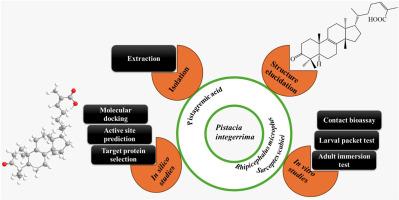In silico investigation and experimental validation of pistagremic acid isolated from Pistacia integerrima against Rhipicephalus microplus and Sarcoptes scabiei
IF 1.7
Q3 PARASITOLOGY
Current research in parasitology & vector-borne diseases
Pub Date : 2025-01-01
DOI:10.1016/j.crpvbd.2025.100296
引用次数: 0
Abstract
Rhipicephalus microplus and Sarcoptes scabiei are major ectoparasites affecting both humans and animals, causing significant economic losses to the dairy and agricultural sectors. This study aimed to evaluate the in vitro and in silico efficacy of pistagremic acid (PA), a natural compound isolated from Pistacia integerrima, against these parasites. Different concentrations of the compound were tested using the adult immersion test (AIT) and larval packet test (LPT) to assess their in vitro effects on mites and various tick life stages. Molecular docking was conducted to examine the interactions of PA with glutathione S-transferases (GSTs) of S. scabiei and R. microplus proteins. The results demonstrated high in vitro acaricidal activity, with significant efficacy in both AIT and LPT assays. In silico studies identified PA as a key bioactive compound, showing strong binding interactions with S. scabiei GST (binding energy: 10.0 kcal/mol) compared to permethrin (−8.1 kcal/mol) and with R. microplus GST (docking score: 7.8 kcal/mol) compared to ivermectin (−8.3 kcal/mol). Overall, PA shows strong potential as a plant-derived alternative for managing tick and mite infestations, supporting its further exploration as a novel acaricidal agent.

真木开心果酸对微头虫和疥螨的抑菌作用的实验研究
微型鼻头虫和疥螨是影响人类和动物的主要体外寄生虫,对乳制品和农业部门造成重大经济损失。本研究旨在评价从合心木中分离的天然化合物pistagremic acid (PA)对这些寄生虫的体外和体内药效。采用成虫浸没试验(AIT)和幼虫包袋试验(LPT)对不同浓度的化合物进行体外杀灭螨类和蜱虫不同生命阶段的效果评价。通过分子对接研究PA与疥螨和微孢子虫蛋白谷胱甘肽s -转移酶(GSTs)的相互作用。结果显示出高的体外杀螨活性,在AIT和LPT试验中均有显著的效果。在硅研究中发现PA是一种关键的生物活性化合物,与S. scabiei GST(结合能:10.0 kcal/mol)和R. microplus GST(对接分数:7.8 kcal/mol)具有很强的结合作用,而氯菊酯(- 8.1 kcal/mol)和伊维菌素(- 8.3 kcal/mol)具有很强的结合作用。综上所述,PA作为一种植物源替代品,具有很强的潜力来管理蜱虫和螨虫的侵害,支持其作为一种新型杀螨剂的进一步探索。
本文章由计算机程序翻译,如有差异,请以英文原文为准。
求助全文
约1分钟内获得全文
求助全文

 求助内容:
求助内容: 应助结果提醒方式:
应助结果提醒方式:


